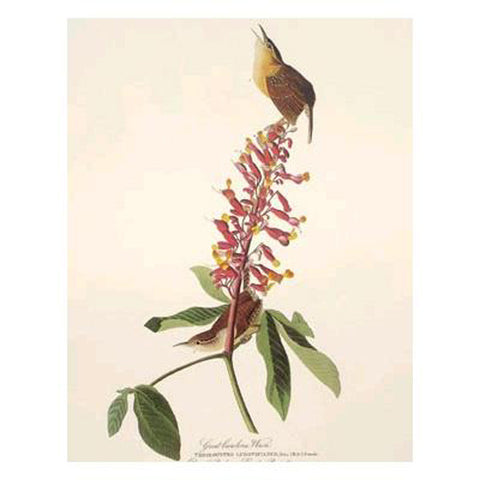Description
Carolina Wren, Thryothorus ludovicianus
Flora: scarlet buckeye, Aesculus pavia
Print size: 26 1/4" x 39 1/4"; image size: 12" x 18 1/2"
Princeton Audubon Limited Edition - produced 1985
Based on a composition painted in Louisiana or Mississippi in 1822. Audubon's young assistant, Joseph Mason, was the artist who painted the blossoming twig which Audubon identified as a "Dwarf horse chestnut."
The Carolina wren seems so full of song-clear, strong, yet sweet. This song consists of loud, rapid triplets, described variously as a spirited three-part tea-kettle, tea-kettle, tea-kettle, or a two-part wheedle, wheedle repeated half a dozen times. Unlike most other wrens, it is nonmigratory. Common in the Southeastern United States, it tends to extend its northern ranges after mild winters. Then, when severe winters return and decimate the ranks, the range limit retracts.
Audubon had his own interpretations of the wren's melodic phrases. In April 1840 when in Richmond, Virginia, he wrote; "The spring is now fairly open, and this day although quite rainy and sad looking I have seen several Hum birds and heard the ever pleasing note of 'Sweet William' from the Carolina Wren..." On another occasion he wrote of the bird: "The little fellow droops its tail and sings with great energy a short ditty somewhat resembling the words come-to-me, come-to-me, repeated several times in quick succession, so loud, and yet so mellow, that it is always agreeable to listen to them."
EHJ
Princeton Audubon prints are direct-camera facsimile lithographs of the Robert Havell Jr. (1793-1878) engravings for The Birds of America (1827-38). Princeton's Double elephant Folio prints are issued in limited editions of 500 or 1500 prints. All are numbered and have a seal in the bottom margin to demonstrate their authenticity.
Printed on heavy Mohawk paper that is recommended by the Library of Congress for archives, the paper is specially toned to match the average paper color of the antique originals.
Item Number:
1715


